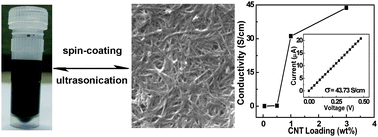Recyclable and electrically conducting carbon nanotube composite films
Abstract

* Corresponding authors
a
Materials Physics and Applications Division, Los Alamos National Laboratory, Los Alamos, NM 87545
E-mail:
gfzou@lanl.gov, qxjia@lanl.gov
Fax: +001 505 6653164
Tel: +001 505 6640445
b Department of Physics, University of Connecticut, 2152 Hillside Road, Unit 3046, Storrs, CT 06269

 Please wait while we load your content...
Something went wrong. Try again?
Please wait while we load your content...
Something went wrong. Try again?
G. Zou, M. Jain, H. Yang, Y. Zhang, D. Williams and Q. Jia, Nanoscale, 2010, 2, 418 DOI: 10.1039/B9NR00257J
To request permission to reproduce material from this article, please go to the Copyright Clearance Center request page.
If you are an author contributing to an RSC publication, you do not need to request permission provided correct acknowledgement is given.
If you are the author of this article, you do not need to request permission to reproduce figures and diagrams provided correct acknowledgement is given. If you want to reproduce the whole article in a third-party publication (excluding your thesis/dissertation for which permission is not required) please go to the Copyright Clearance Center request page.
Read more about how to correctly acknowledge RSC content.
 Fetching data from CrossRef.
Fetching data from CrossRef.
This may take some time to load.
Loading related content
